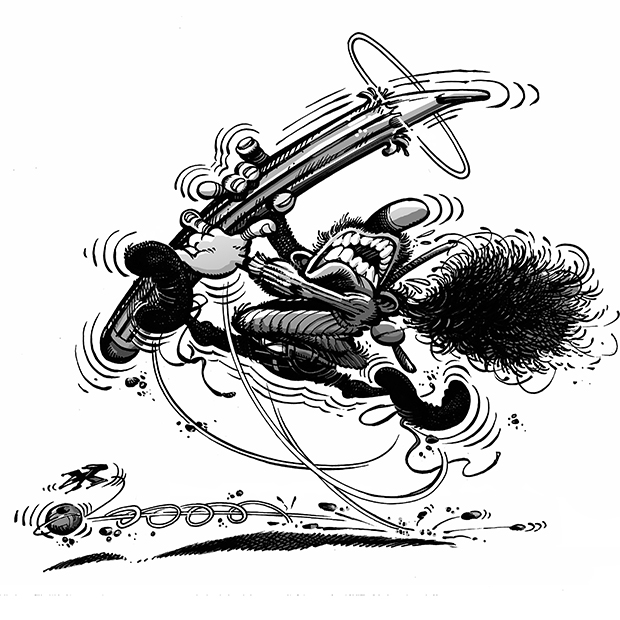About

According to one of his most usual, ego-driven biographical blurbs, “KLAUS was born somewhere in Western Europe at some point within last century. For many years, he suffered from a syndrome called architecture, from which he is still struggling to recover. Showing an early passion for drawing, he was introduced to comic books at a very early age by his family and educators, to their later deepest regret. His other self, camouflaged as an architect and architectural scholar, publishes works and scholarly articles in Art & Architecture magazines and in books, as well as on his online blog.”
Klaustoon’s Blog
In March 2009, a couple of years after helping close another architectural magazine with his cartoons (Bilbao-based journal Arquine, this time), largely unknown cartoonist Klaus came out of his niche and went online with Klaustoon’s blog, a site firstly dedicated to satirize the people & events in and around the Harvard Graduate School of Design. That is: a niche within a niche.
The blogosphere offered a new, extended territory to deepen into the waters of self-cultivated mauditisme by producing elusive, often incomprehensible, and many times plainly unfunny satire on random architectural issues. The amplified exposure of the internet also promised exponentially increased possibilities for offense, and for being sued; after all, Klaus had always been an author fundamentally concerned with the importance of developing a distinctive style, which has led him into spending most of his career systematically copying the styles of the most distinctive masters of the Franco-Belgian bande dessinée (André Franquin and his heirs, Tome & Janry, are the most obvious, but as he got more confident, he went on to plagiarize authors such François Schuiten and Andreas Martens, Spanish comic artist Jan, the Japanese mangaka Katsuhiro Otomo and Masamune Shirow, and, more recently, Moebius, amongst many others). Only his total lack of ability and almost nonexistent popularity had prevented him from effectively being sued for plagiarism. The online exposure of his work promised, however, a major step forward. As for the possibilities of being sure, we mean.
A who’s who of architecture
As mentioned earlier, Klaus: The Blog started as a tongue-in-cheek sarcastic review of the Harvard GSD unleashed by an especially surrealistic exchange between Ben Van Berkel and Prescott Scott Cohen, which rejoiced in presenting the visible heads of architectural intellectuality in their dialectic pajamas. However, due to Klaus’s lack of perseverance and his fickle nature, it soon evolved into an uncertain terrain that tackled the most disparate aspects of architecture’s present, future and History, exploring both obscure corners of architectural Theory and its contemporary issues with equal absence of any criteria. In the first three years since it opened, many were the personalities that have passed through the blog: obviously, many distinguished GSD faculty members such as Michael Hays, Antoine Picon, Sanford Kwinter or Mohsen Mostafavi, Preston Scott Cohen and Michael Meredith (and Hilary Sample), but also first-rate architects and Pritzker award winners such as Wes Jones, Eduardo Souto de Moura and Álvaro Siza, Peter Zumthor, or Kazuyo Sejima and Ryue Nishizawa; modern and postmodern icons such as Mies van der Rohe and Le Corbusier, Phillip Johnson, Michael Graves, Peter Eisenman, Robert Venturi and Denise Scott Brown, renowned past and present theoreticians such as Reyner Banham (a personal obsession of his), Bruno Latour and Peter Sloterdijk or Homi Bhabha -with the addition of young guns (not anymore) such as Kazys Varnelis and Joseph Grima-, verbal terrorists like Jeff Kipnis, short people such as Sylvia Lavin, or multimedia personalities such as Steve Jobs. Among those, a place of honor corresponds, of course, to Rem Koolhaas, whose different cartoonizations have been a recurrent source for celebration and joy amongst the followers of the site and a sure trigger for future lawsuits.
Klaustoon Outside the Blog
In this lapse, Klaus’s cartoons have also made their way into different architectural publications such as Aequus, Arq, Arq’a, AD – Architectural Design, Bitácora Arquitectura, The Architectural Review, eVolo, Clog, Conditions, Harvard Design Magazine, the Harvard Satirical Press, (In)forma, MAS Context, STUDIO, PRAXIS, Project International, Thresholds, Volume. Among those, a special note should be dedicated to MAS Context, which has been the source of many interesting collaborations in and outside Chicago, The New City Reader, Joseph Grima & Kazys Varnelis-edited newspaper-performance, which provided him the first platform for a continuous (if time-limited) collaboration, Uncube, which featured amongst its virtual pages Klaus’s first online regular section, A10, whose full-page illustrations were later collected in a book, and last but not at all least, Arquine, which has been featuring, since 2013, Klaus’s Arquinoir column.
Adding to these, his work has made into books such as Caricature architettoniche: Satira e critica del progetto moderno (Quodlibet, 2015), Beyond urbanism (List Lab, 2015), REM. Le Bon, la Brute…(Les Éditions B2, 2014), Goodbye Topolinia (Malcor D’Edizioni, 2013), The Importance of the Way Stories are Being Told (DPR-Barcelona, 2012), and Eme 3: Bottom Up(2012). It has also been featured (thanks to the initiative of some nice people who took care of it) in small installations and bigger exhibitions, such as Klaus.Toon: From New York to Portimao (Ordem dos Arquitectos de Portugal, 2010), Dispatches from the GSD: 075 Years of Design (Harvard GSD, 2011), MAS Context: Analog (Chicago, 2011), Building Comics (Naples, 2013), Chatter: Architecture Talks Back, (Art Institute of Chicago, 2015), Drawn Theories / Teorie disegnate(Ca’ Pesaro Museum of Modern Art, Venice, 2016), Arquinoir by Klaus (Centro cultural de España, Mexico DF, 2018), La Imagen del Arquitecto (Santiago de Chile, 2018), and even more importantly, it made its way to OMA’s canteen.
In his other, more serious life, he’s also an architect and architectural scholar, currently holding a position as Associate professor of the Theory and History of Architecture, whose research focuses on unbuilt architecture, the History of Architectural Utopia, and the intersections between Architecture and Media (Comics, Cinema, Countercultural Magazines, and Video Games). He’s not ashamed of it.

